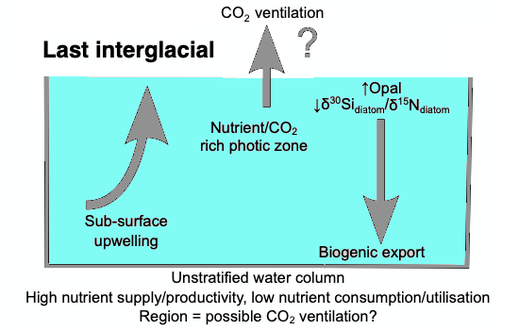Photic zone
| Aquatic layers |
|---|
| Stratification |
|
| See also |
The sunlight zone is 200 meters deep.The photic zone, euphotic zone, epipelagic zone, or sunlight zone is the uppermost layer of a body of water that receives sunlight, allowing phytoplankton to perform photosynthesis. It undergoes a series of physical, chemical, and biological processes that supply nutrients into the upper water column. The photic zone is home to the majority of aquatic life due to the activity (primary production) of the phytoplankton. The thicknesses of the photic and euphotic zones vary with the intensity of sunlight as a function of season and latitude and with the degree of water turbidity. The bottommost, or aphotic, zone is the region of perpetual darkness that lies beneath the photic zone and includes most of the ocean waters.[1]
Photosynthesis in photic zone
In the photic zone, the photosynthesis rate exceeds the respiration rate. This is due to the abundant
Life in the photic zone
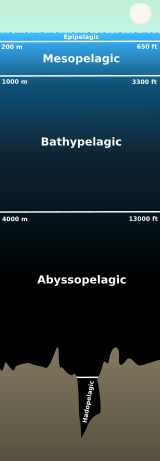
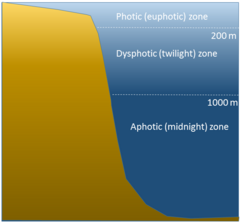
Ninety percent of
Detritivores and scavengers are rare in the photic zone. Microbial decomposition of dead organisms begins here and continues once the bodies sink to the aphotic zone where they form the most important source of nutrients for deep sea organisms.[5] The depth of the photic zone depends on the transparency of the water. If the water is very clear, the photic zone can become very deep. If it is very murky, it can be only fifty feet (fifteen meters) deep.
Animals within the photic zone use the cycle of light and dark as an important environmental signal, migration is directly linked to this fact, fishes use the concept of dusk and dawn when its time to migrate, the photic zone resembles this concept providing a sense of time. These animals can be herrings and sardines and other fishes that consistently live within the photic zone.[6]
Nutrient uptake in the photic zone
Due to biological uptake, the photic zone has relatively low levels of nutrient concentrations. As a result, phytoplankton doesn't receive enough nutrients when there is high water-column stability.[7] The spatial distribution of organisms can be controlled by a number of factors. Physical factors include: temperature, hydrostatic pressure, turbulent mixing such as the upward turbulent flux of inorganic nitrogen across the nutricline.[8] Chemical factors include oxygen and trace elements. Biological factors include grazing and migrations.[9] Upwelling carries nutrients from the deep waters into the photic zone, strengthening phytoplankton growth. The remixing and upwelling eventually bring nutrient-rich wastes back into the photic zone. The Ekman transport additionally brings more nutrients to the photic zone. Nutrient pulse frequency affects the phytoplankton competition. Photosynthesis produces more of it. Being the first link in the food chain, what happens to phytoplankton creates a rippling effect for other species. Besides phytoplankton, many other animals also live in this zone and utilize these nutrients. The majority of ocean life occurs in the photic zone, the smallest ocean zone by water volume. The photic zone, although small, has a large impact on those who reside in it.
Photic zone depth

The depth is, by definition, where radiation is degraded down to 1% of its surface strength.
Light attenuation

and in the process called photosynthesis absorb light
in the blue and red range through photosynthetic pigments
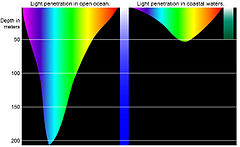
Most of the solar energy reaching the Earth is in the range of visible light, with wavelengths between about 400-700 nm. Each colour of visible light has a unique wavelength, and together they make up white light. The shortest wavelengths are on the violet and ultraviolet end of the spectrum, while the longest wavelengths are at the red and infrared end. In between, the colours of the visible spectrum comprise the familiar “ROYGBIV”; red, orange, yellow, green, blue, indigo, and violet.[12]
Water is very effective at absorbing incoming light, so the amount of light penetrating the ocean declines rapidly (is attenuated) with depth. At one metre depth only 45% of the solar energy that falls on the ocean surface remains. At 10 metres depth only 16% of the light is still present, and only 1% of the original light is left at 100 metres. No light penetrates beyond 1000 metres.[12]
In addition to overall attenuation, the oceans absorb the different wavelengths of light at different rates. The wavelengths at the extreme ends of the visible spectrum are attenuated faster than those wavelengths in the middle. Longer wavelengths are absorbed first; red is absorbed in the upper 10 metres, orange by about 40 metres, and yellow disappears before 100 metres. Shorter wavelengths penetrate further, with blue and green light reaching the deepest depths.[12]
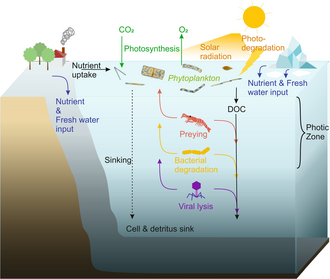
This is why things appear blue underwater. How colours are perceived by the eye depends on the wavelengths of light that are received by the eye. An object appears red to the eye because it reflects red light and absorbs other colours. So the only colour reaching the eye is red. Blue is the only colour of light available at depth underwater, so it is the only colour that can be reflected back to the eye, and everything has a blue tinge under water. A red object at depth will not appear red to us because there is no red light available to reflect off of the object. Objects in water will only appear as their real colours near the surface where all wavelengths of light are still available, or if the other wavelengths of light are provided artificially, such as by illuminating the object with a dive light.[12]
Water in the
The ocean can be divided into depth layers depending on the amount of light penetration, as discussed in pelagic zone. The upper 200 metres is referred to as the photic or euphotic zone. This represents the region where enough light can penetrate to support photosynthesis, and it corresponds to the epipelagic zone. From 200 to 1000 metres lies the dysphotic zone, or the twilight zone (corresponding with the mesopelagic zone). There is still some light at these depths, but not enough to support photosynthesis. Below 1000 metres is the aphotic (or midnight) zone, where no light penetrates. This region includes the majority of the ocean volume, which exists in complete darkness.[12]
Paleoclimatology

The initial development of the halocline and
Phytoplankton side notes.

Phytoplankton are restricted to the photo zone only. As its growth is completely dependent upon photosynthesis. This results in the 50–100 m water level inside the ocean. Growth can also come from land factors, for example minerals that are dissolved from rocks, mineral nutrients from generations of plants and animals ,that made its way into the photic zone.[25]

An increase in the amount of phytoplankton also creates an increase in zooplankton, the zooplankton feeds on the phytoplankton as they are at the bottom of the food chain.[25]
Dimethylsulfide
Dimethylsulfide loss within the photic zone is controlled by microbial uptake and photochemical degradation. But what exactly is dimethylsulfide and why is it important? This compound (see the photo) helps regulate sulfur cycle and ecology within the ocean. Marine bacteria, algae, coral and most other organisms within the ocean release this, constituting a range of gene families.
However this compound can be toxic to humans if swallowed, absorbed through the skin and inhaled. Proteins within plants and animals depend on this compound. Making it a significant part of ecology, it's good to know that it lives in the photic zone as well. [1]
See also
- Electromagnetic absorption by water
- Epipelagic fish
- Mesophotic coral reef
References
- ^ "Photic zone | Marine Life, Photosynthesis & Light | Britannica". www.britannica.com. Retrieved 2023-11-27.
- )
- ^ Photic zone Encyclopædia Britannica Online. 14 August 2009.
- ^ "Trophic Levels of Coral Reefs". Sciencing. Retrieved 2019-11-22.
- ^ "Photic Zone - an overview | ScienceDirect Topics". www.sciencedirect.com. Retrieved 2023-11-27.
- ^ "Photic Zone - an overview | ScienceDirect Topics". www.sciencedirect.com. Retrieved 2023-12-01.
- ISBN 978-0-87933-213-6.
- ISSN 0198-0149.
- ISSN 0024-3590.
- ISSN 2156-2202.
- ^ Ocean Explorer NOAA. Updated: 26 August 2010.
- ^ a b c d e f Webb, Paul (2019) Introduction to Oceanography, chapter 6.5 Light, Rebus Community, Roger Williams University, open textbook.
 Material was copied from this source, which is available under a Creative Commons Attribution 4.0 International License.
Material was copied from this source, which is available under a Creative Commons Attribution 4.0 International License.
- ^ "What Are "Proxy" Data? | National Centers for Environmental Information (NCEI) formerly known as National Climatic Data Center (NCDC)". www.ncdc.noaa.gov. Retrieved 2020-10-20.
- ^ ISSN 1814-9332..
 Material was copied from this source, which is available under a Creative Commons Attribution 3.0 International License
Material was copied from this source, which is available under a Creative Commons Attribution 3.0 International License - S2CID 4329978.
- ^ S2CID 24116155.
- ISSN 0883-8305.
- ISSN 0921-8181.
- (PDF) from the original on 2022-10-09.
- ISSN 0277-3791.
- ISSN 0277-3791.
- S2CID 4082469.
- ISSN 0277-3791.
- ISSN 0277-3791.
- ^ a b "Accumulation". www.dnr.louisiana.gov. Retrieved 2023-12-01.


